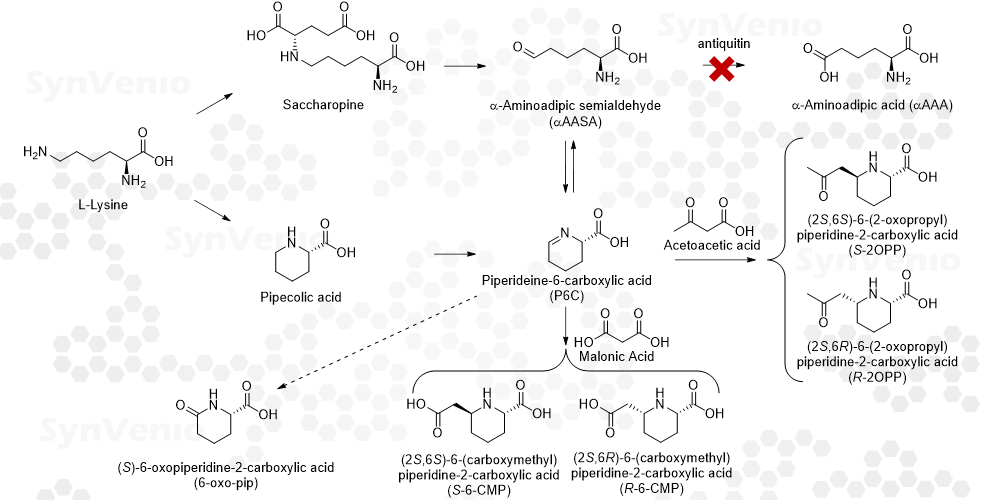R-2OPP
Biomarker of pyridoxin dependent epilepsy (PDE-ALDH7a1)
| Product ID: | SV7089 |
|---|---|
| Synonyms: | (2S,6R)-6-(2-oxopropyl)piperidine-2-carboxylic acid, 2-OPP, R-2-OPP |
| Tags: | 2-OPP, 2OPP, Biomarker, PDE |

| Product | Price | Estimated Shipping Time | Purchase |
|---|---|---|---|
| R-2OPP - 1 mg | €650.00 | 1-3 days | |
| R-2OPP - 2 mg | €950.00 | 1-3 days | |
| R-2OPP - 5 mg | €1,600.00 | 1-3 days | |
| R-2OPP - 10 mg | €2,200.00 | 1-3 days | |
| R-2OPP - 50 mg | €3,200.00 | 1-3 days | |
| R-2OPP - 100 mg | €4,500.00 | 1-3 days |
Product information
-
Function
R-2OPP is a biomarker for pyridoxin dependent epilepsy (PDE).
-
Mode of action
In pyridoxin dependent epilepsy, a defect in the gene encoding for α-aminoadipic semialdehyde (α-AASA) dehydrogenase (antiquitin), results in the accumulation of α-AASA which is in equilibrium with the reactive Δ1-piperideine-6-carboxylic acid (P6C).1,2 Condensation of P6C with pyridoxal 5′-phosphate (PLP, active form of vitamin B6), results in a deficiency of PLP, thought to be the main pathophysological pathophysiological mechanism of PDE.3
Reaction of the accumulating P6C with acetoacetate or malonic acid under physiological conditions results in the formation of the biomarkers (2S)-6-(2–oxopropyl)piperidine-2-carboxylic acid (2-OPP) and (2S)-6-(carboxymethyl)piperidine-2-carboxylic acid (CMP).4,5 The formation of another biomarker, 6-oxo-pip, is also formed under a yet unknown mechanism.6

-
Applications
2-OPP can be applicable as first-tier PDE-ALDH7A1 newborn screening biomarker in dried blood spot (DBS), through a direct-infusion MS method compatible with common newborn screening workflows. Therefore, it can be used as biomarker for treatment monitoring and risk stratification for PDE-ALDH7A1 patients. 4
A method has been validated that may serve as a routine assay for diagnosis and monitoring of PDE.7
-
Chemical Information
CAS No.: n/a
SMILES: OC([C@@H]1CCC[C@H](CC(C)=O)N1)=O
Chemical formula: C9H15NO3
Molecular weight: 185.22
Purity: > 95%
Identity: 1H NMR
Shipping temperature: 20°C
Storage temperature: -20°C
Calculator
Dissolve the required mass in your desired stock volume.
Dilute the required volume of your stock solution to the desired final volume.

